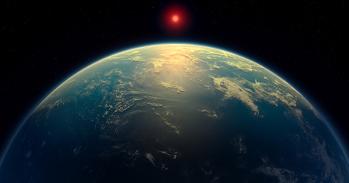
The rediscovery of a lost planet could pave the way for the detection of a world within the habitable ‘Goldilocks zone’ in a distant solar system.
The rediscovery of a lost planet could pave the way for the detection of a world within the habitable ‘Goldilocks zone’ in a distant solar system.
NGTS-11b is an interesting find that takes us one step closer to finding planets in the Goldilocks zone
Ed Gillen
The planet, the size and mass of Saturn with an orbit of thirty-five days, is among hundreds of ‘lost’ worlds that astronomers, including from the University of Cambridge, are using new techniques to track down and characterise, in the hope of finding cooler planets like those in our solar system, and even potentially habitable planets.
Reported in Astrophysical Journal Letters, the planet named NGTS-11b orbits a star 620 light-years away and is located five times closer to its sun than Earth is to our own.
The planet was originally found in a search for planets in 2018 by the University of Warwick-led team using data from NASA’s TESS telescope. This uses the transit method to spot planets, scanning for the tell-tale dip in light from the star that indicates that an object has passed between the telescope and the star.
However, TESS only scans most sections of the sky for 27 days. This means many of the longer period planets only transit once in the TESS data: without a second observation the planet is effectively lost. Researchers from Cambridge’s Cavendish Laboratory are part of the Next-Generation Transit Survey (NGTS) team which, after identifying a single transit event in the TESS data of the star NGTS-11, monitored the system in search of additional transits to confirm the planetary nature of the transiting object.
“By chasing that second transit down we’ve found a longer period planet. It’s the first of hopefully many such finds pushing to longer periods,” said lead author Dr Samuel Gill from the University of Warwick. “These discoveries are rare but important, since they allow us to find longer period planets than other astronomers are finding. Longer period planets are cooler, more like the planets in our own solar system.”
NGTS-11b has a temperature of only 160°C – cooler than Mercury or Venus. Although this is still too hot to support life as we know it, it is closer to the Goldilocks zone than many previously discovered planets which typically have temperatures above 1000°C. The Goldilocks zone refers to a range of orbits that would allow a planet or moon to support liquid water: too close to its star and it will be too hot, but too far away and it will be too cold.
“While we have discovered many planets that orbit close to their host star, we know of fewer at longer periods and cooler temperatures, which makes NGTS-11b an interesting find that takes us one step closer to finding planets in the Goldilocks zone,” said co-author Dr Ed Gillen from Cambridge’s Cavendish Laboratory. “Longer period planets like NGTS-11b may help us to better understand the various evolutionary processes that planetary systems undergo both during and after their formation.”
NGTS has twelve state-of-the-art telescopes at its site in Chile, which means that researchers can monitor multiple stars for months on end, searching for lost planets. The dip in light from NGTS-11b is only 1% deep and occurs only once every 35 days, putting it out of reach of other telescopes.
There are hundreds of single transits detected by TESS that researchers will be monitoring using this method. This will allow them to discover cooler exoplanets of all sizes, including planets more like those in our own solar system. Some of these will be small rocky planets in the Goldilocks zone that are cool enough to host liquid water oceans and potentially extra-terrestrial life.
The research was supported by the Science and Technology Facilities Council (STFC), part of UK Research and Innovation (UKRI).
Reference:
Samuel Gill et al. ‘NGTS-11 b (TOI-1847 b): A Transiting Warm Saturn Recovered from a TESS Single-transit Event.’ The Astrophysical Journal Letters (2020). DOI: 10.3847/2041-8213/ab9eb9
Adapted from a University of Warwick press release.

The text in this work is licensed under a Creative Commons Attribution 4.0 International License. Images, including our videos, are Copyright ©University of Cambridge and licensors/contributors as identified. All rights reserved. We make our image and video content available in a number of ways – as here, on our main website under its Terms and conditions, and on a range of channels including social media that permit your use and sharing of our content under their respective Terms.




